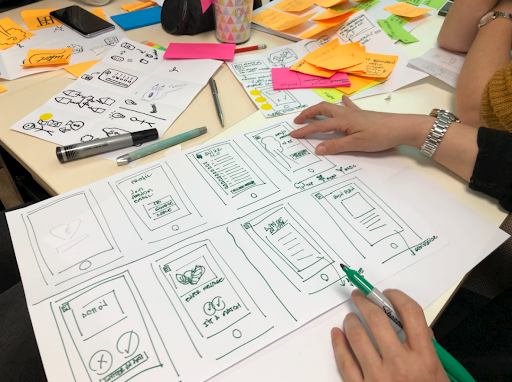UX stands for user experience, and from the very name, it’s clear that we’re talking about something both complex and abstract. People often develop feelings towards products and processes that even they don’t fully understand.
Sure, when you ask them if they like something, they can immediately answer with a quick yes or no. However, when you ask them to elaborate a bit or single out elements that have made the experience pleasant or unpleasant for them, they usually don’t have a straight answer.
They often don’t even know the answer. What bothers them probably plays a minor part, but there’s something else underneath — a truly major problem that just ruins their overall experience.
So, when even the user doesn’t understand their experience most of the time, how can you hope to do it?
Well, the right approach to UX research can bring you pretty close to this.
1.Developing a UX research plan
The first task on your list should be setting up a UX research plan. Consider this an outline of all you plan to do with the research. You start by stating your goals and objectives, as well as list methodology that you’ll use to realize them. Since you are collecting and processing user data, you need to make sure that everything is handled ethically and in compliance with the regulations.
There are a few big reasons for making this plan. First, you need to ensure that there’s a timeline. A project without a timeline is bound to fail, mostly due to the Parkinson’s Law of deadlines. They state that any task will expand to fill all the available time to the deadline. This usually involves a lot of procrastination.
Second, it ensures that you have the resources necessary to conduct all the methods. You don’t want to cut the project short because you lack the resources for its conclusion. This way, you’ll not only miss out on the results, but you’ll also waste all the resources and effort obtaining the data that you’ll have no use for afterward.
Third, it allows you to track the process by setting adequate milestones. What does this mean? Well, if you only set two points – the starting point and the ending point, you have to wait until the end to see if things are moving in the right direction. If you set milestones, you’ll be able to spot problems, roadblocks, and bottlenecks in time and adjust.
Ultimately, you want to state some basic logistical issues like which tools and platforms will be used and who is on the task (the list of the whole team with their roles).
2.Finding the right answers
The biggest challenge lies in finding the right answers, but this means starting from the top. As always, in order to find the right answers, you need to learn how to ask the right questions. Here are a few tips to help you out:
The first thing you need to do is align questions with your objectives. What kind of information would contribute to your research the most? What kind of info would you like to find out the most? Is there an area where you’re the most in the dark? Asking this question might not yield you an ideal response but there’s no harm in trying. If anything, you’re missing out on a potentially life-saving answer by skipping this question.
Sometimes, the survey taker is more articulate and introspective than you credit them for. Exactly because of this, you don’t want to pigeonhole them. Give them the creative freedom of an open-ended question and they will surprise you.
It’s also important to avoid asking leading questions. The biggest problem with most research is that they start with an intention to prove something and rig an entire survey to get the answer they need. However, you’re not a professor trying to cheat your way up the academic ladder—you’re a business owner/manager trying to improve your service. You need real answers.
Make sure to keep the language simple and questions clear. The last thing you want is to sound ambiguous or confuse the survey taker. What if they had the answer, but they just didn’t understand the question? This is no short of a tragedy, and it’s something you need to put in your best effort to avoid.
3.Identify the target audience
The main reason you even need to conduct UX research and not just “figure out the answers yourself” is that you’re just one person. Not only that, but you might not even be a member of your target audience. Do you think the owners of Walmart buy at Walmart, or does Jeff Bezos still order things from Amazon?
In other words, in order to avoid the risk of getting misled by individual preferences, you need to have a large enough target audience (to make the statistics relevant). Second, you need to make sure you’re targeting the right group.
A lot of people fear narrowing down their scope to just one group or individual, but the truth is that by trying to appeal to everyone, you’ll miss everyone.
You need to start by creating a customer profile (or persona). The best way to do so is to draw from your existing data. In 2024, every business will be using some kind of analytical platform to see the average age, gender, location, and background of their audience.
Just be careful of averages, as they can often be misleading. If your product appeals to 10-year-olds and 60-year-olds, the average customer will be someone 35 years old, which misses both of these groups. Instead, you might want to do a bit of audience segmentation. This way, you can organize your audience into a few focus groups and analyze their data independently.
Also, you can backtrack from your product. Evaluate your product and consider who it will be useful to. Still, a product lives a life of its own when it hits the shelves. The answer to this particular question could surprise you.
4.Proceed with data collection
The next stage is all about data collection and various ways in which you can obtain the data you need.
First, you want to dig into the analytics and get some raw data. With modern AI-powered analytical tools, you can get info about user behavior without ever asking them a direct question.
Second, you should reach out to some of your audience members with direct survey questions (that you’ve settled on a while back). Keep in mind that if you’ve picked your audience right, the language should be adjusted to their knowledge level. If you’ve segmented your audience (as we’ve suggested), you might also want to have different sets of questions for different focus groups.
Sometimes, however, you won’t look for stats derived from large numbers. Sometimes, you want to conduct direct interviews with individual users. This way, you get a face-to-face format of survey taking (like those that were used traditionally). You would be surprised at how insightful these can be.
Lastly, you can always go for something like usability testing and observation. There’s no need to just take their word for it. Let them use the product in front of you, and you’ll get all the information you need.
It’s the most effective way to combine these methods. This way, the finds will be solid and reliable.
5.Engage with data analysis
Lastly, you want to process the data you’ve gathered and turn it into actionable information.
To put it as simply as possible – you don’t want to hear that 20% of your audience is dissatisfied with your service. What you really want to know is what you can do to make them feel better about it. You don’t need stats; what you’re really looking for are insights.
With the help of deep learning, machine learning, and AI tools, data analytics are more reliable than ever before.
Most commonly, these insights are about your user interface (UI), product usability, customer service, or your messaging (as a part of your overall marketing campaign). Once you identify the problem, you can spring into action and fix the issue.
Afterward, you need to track and monitor your KPIs (key performance indicators) in order to see if the implemented change has achieved the desired effect. If not, you keep looking. However, even if things are better, your job is not done. Your job is never done. The product improvement and UX research happen in a loop. This is one of the biggest reasons why agile development is so big in the modern world.
User opinions and behaviors are what matter the most
Users are individual units that compose the market, and it’s the market that decides whether your product/service is good or not. However, this personification of the market is not very vocal about its feelings, especially when it comes to breaking down everything right or wrong with your product. So, you have to listen carefully. Once you learn the proper foundations of UX research, this shouldn’t be a problem any longer.
By Srdjan Gombar
Veteran content writer, published author, and amateur boxer. Srdjan has a Bachelor of Arts in English Language & Literature and is passionate about technology, pop culture, and self-improvement. In his free time, he reads, watches movies, and plays Super Mario Bros. with his son.




